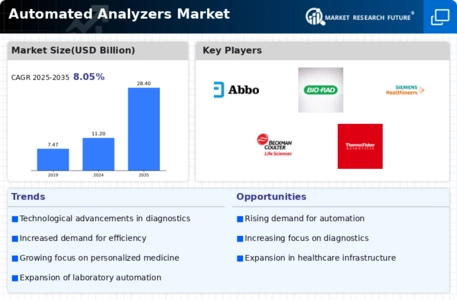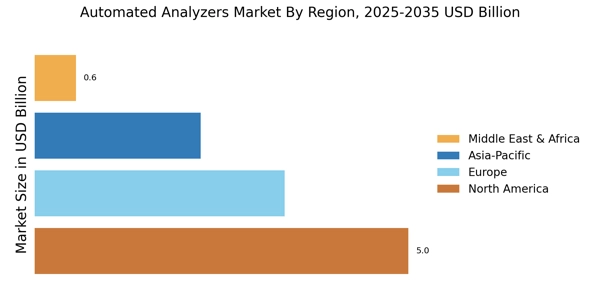Growing Prevalence of Chronic Diseases
The rising prevalence of chronic diseases is a critical factor influencing the Automated Analyzers Market. Conditions such as diabetes, cardiovascular diseases, and cancer require regular monitoring and timely diagnosis, which automated analyzers facilitate. The World Health Organization has reported that chronic diseases account for approximately 70% of all deaths worldwide, underscoring the urgent need for effective diagnostic tools. Automated analyzers enable healthcare providers to conduct routine tests efficiently, thereby improving patient outcomes. As the global population ages and the incidence of chronic diseases increases, the demand for automated analyzers is likely to escalate, driving market growth. This trend indicates a shift towards proactive healthcare management, where early detection and continuous monitoring are paramount.
Rising Demand for Point-of-Care Testing
The increasing demand for point-of-care testing is a pivotal driver for the Automated Analyzers Market. As healthcare systems strive for efficiency, the need for rapid diagnostic results has surged. Point-of-care testing allows for immediate decision-making, which is crucial in emergency situations. According to recent data, the point-of-care testing segment is projected to grow at a compound annual growth rate of over 10% in the coming years. This trend is likely to propel the adoption of automated analyzers, as they provide quick and accurate results, thereby enhancing patient care. The integration of automated analyzers in point-of-care settings not only streamlines workflows but also reduces the burden on laboratory facilities, indicating a shift towards decentralized healthcare solutions.
Increased Focus on Laboratory Automation
The emphasis on laboratory automation is transforming the landscape of the Automated Analyzers Market. Laboratories are increasingly adopting automated systems to enhance productivity and minimize human error. Automation in laboratories can lead to a reduction in operational costs by approximately 30%, as it optimizes resource allocation and improves throughput. Furthermore, the demand for high-throughput screening in drug development and clinical diagnostics is driving the need for sophisticated automated analyzers. As laboratories seek to improve efficiency and accuracy, the market for automated analyzers is expected to expand significantly. This trend suggests that investments in automation technologies will continue to rise, fostering innovation and enhancing the capabilities of laboratory operations.
Rising Investment in Healthcare Infrastructure
The increasing investment in healthcare infrastructure is a significant driver for the Automated Analyzers Market. Governments and private entities are allocating substantial resources to enhance healthcare facilities, particularly in emerging economies. This investment is aimed at improving diagnostic capabilities and expanding access to quality healthcare services. According to recent estimates, healthcare spending is projected to grow by over 5% annually, which is likely to boost the demand for advanced diagnostic tools, including automated analyzers. Enhanced healthcare infrastructure facilitates the integration of cutting-edge technologies, thereby improving patient care and operational efficiency. As healthcare systems evolve, the role of automated analyzers in diagnostics is expected to become more pronounced, indicating a robust growth trajectory for the market.
Technological Innovations in Diagnostic Equipment
Technological innovations are significantly shaping the Automated Analyzers Market. Advancements in artificial intelligence, machine learning, and data analytics are enhancing the capabilities of automated analyzers, making them more efficient and user-friendly. For instance, the integration of AI algorithms allows for improved accuracy in test results and faster processing times. The market for diagnostic equipment is expected to witness a growth rate of around 8% annually, driven by these technological advancements. Moreover, the development of portable and compact analyzers is expanding their applicability in various settings, including remote and resource-limited areas. This evolution in technology not only enhances diagnostic capabilities but also broadens the accessibility of healthcare services, indicating a promising future for the automated analyzers market.


















Leave a Comment